Altered chord




In music, an altered chord, an example of alteration, is a chord with one or more notes from the diatonic scale replaced by a neighboring pitch in the chromatic scale. Thus the note must be a nonchord tone. According to the broadest definition any chord with a nondiatonic chord tone is an altered chord, while the simplest use of altered chords is the use of "borrowed" chords—borrowed from the parallel key and the most common is the use of secondary dominants.
Alteration, an example of chromaticism, is a compositional and/or improvisational technique for creating greater harmonic interest and variety. A triad has three pitches (by definition), and if each one of which may be raised or lowered a semitone (or not), this allows the production of 33=27 chords, including the original. Alteration is also an analytical technique for explaining why chromaticism occurs in chord progressions by assuming a diatonic origin and, to some extent, function. "An altered chord occurs when one of the standard, functional chords is given another quality by the modification of one or more components of the chord."[2]
For example, altered notes may be used as leading tones to emphasize their diatonic neighbors. Contrast with chord extension: "Whereas chord extension generally involves adding notes that are logically implied, chord alteration involves changing some of the typical notes. This is usually done on dominant chords, and the four alterations that are commonly used are the ♭5, ♯5, ♭9 and ♯9. Using one (or more) of these notes in a resolving dominant chord greatly increases the bite in the chord and therefore the power of the resolution." "The more tension, the more powerful the resolution… we can pile that tension on to make the resolution really spectacular."[3] The five most common types of altered dominants are: V+, V+7 (both raised fifths), V♭5, V7♭5 (both lowered fifths), and Vø7 (lowered fifth and third).[4]
Background
"Borrowing" of this type is seen in music from the Renaissance music era and the Baroque music era (1600–1750), such as with the use of the Picardy third, in which a piece in a minor key has a final or intermediate cadence in the tonic major chord. "Borrowing" is also common in 20th century popular music and rock music.
For example, in music in a major key, such as C major, composers and songwriters may use a B♭ major chord, which is "borrowed" from the key of C minor (where it is the VII chord). Similarly, in music in a minor key, composers and songwriters often "borrow" chords from the tonic major. For example, pieces in C minor often use F major and G major (IV and V chords), which are "borrowed" from the key of C major.
More advanced types of altered chords were used by Romantic music era composers in the 19th century, such as Chopin and by jazz composers and improvisers in the 20th and 21st century. For example, the chord progression on the left uses four unaltered chords:[1]
The progression on the right uses an altered IV chord and is an alteration of the previous progression.[1] The A♭ in the altered chord serves as a leading tone to G, which is the root of the next chord.
The object of such foreign tones is: to enlarge and enrich the scale; to confirm the melodic tendency of certain tones...; to contradict the tendency of others...; to convert inactive tones into active [leading tones]...; and to affiliate the keys, by increasing the number of common tones.[5]
According to one definition, "when a chord is chromatically altered, and the thirds remain large [major] or small [minor], and is not used in modulation, it is an altered chord."[6] According to another definition, "all chords...having a major third, ie., either triads, sevenths, or ninths, with the fifth chromatically raised or chromatically lowered, are altered chords," while triads with a single altered note are considered, "changes of form [quality," rather than alteration.[7]
"Altered...chords contain one or more tones written with accidentals (♯, ♭, or ♮) and therefore foreign to the scale in which they appear, but nevertheless, from their connections and their effect, obviously belonging to the principal key of their phrase."[5] Goldman argues that, once one accepts, "the variability of the scale," the concept of altered chords becomes unnecessary: "In reality, there is nothing 'altered' about them; they are entirely natural elements of a single key system,"[8] and it is, "not necessary," to use the term as each 'altered chord' is, "simply one of the possibilities regularly existing and employed."[9]
Alfred Music argues that only fifths and ninths may be altered, as all other alterations may be interpreted as an unaltered chord tone or, enharmonically, as an altered fifth or ninth (for example, ♯1 = ♭9 and ♭4 = 3).[10][11]
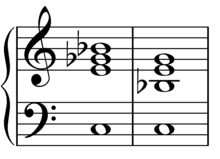
The ♭9 chord is recommended for resolution to minor chords, for example VI7 to ii (G7♭9 to Cm7) in the I-vi-ii-V turnaround. The ♯9 chord is also known as the Purple Haze chord, is most often notated with the enharmonic equivalent ♭3, and is thus used with the blues. The 5 in a ♭5 chord is enharmonically equivalent to a ♯4 or ♯11, but the sharp eleventh chord includes the ♮5 while in the flat fifth chord it is replaced. The ♯5 chord is enharmonically equivalent to a ♭13, does not include the ♮5, and is more common than the ♭13 chord. Both the flat and sharp fifth resolve nicely to the natural ninth.[12]
Altered seventh chord
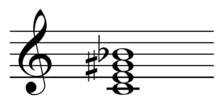
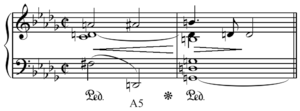

An altered seventh chord is a seventh chord with one, or all,[14] of its factors raised or lowered by a semitone (altered), for example the augmented seventh chord (7+ or 7+5) featuring a raised fifth[15] (C7+5: C–E–G♯–B♭). Most likely the fifth, then the ninth, then the thirteenth.[14] All secondary dominants are altered chords.
In classical music, the raised fifth is more common than the lowered fifth, which in a dominant chord adds Phrygian flavor through the introduction of ♭![]()
Altered dominant
An altered dominant chord is, "a dominant triad of a 7th chord that contains a raised or lowered fifth and sometimes a lowered 3rd."[16] "Generally, altered dominants can be divided into three main groups: altered 5th, altered 9th, and altered 5th and 9th."[11] This definition allows three to five options, including the original:
"Altered or 'alt' on a dominant chord refers to the fifth and ninth being flatted and raised; (b5, #5) and (b9, #9)."[17] "The altered dominant is a dominant seventh chord which contains, in its complete realization, an augmented fifth (+5), a flatted ninth (♭9), an augmented ninth (+9), and an augmented eleventh (+11, or +4)."[18] "♯9(♯2) and ♯5 (sometimes referred to as ♭13) appear to be the most 'characteristic' altered chord tones...since they are also tensions [dissonances or extended chord tones] 9(2) and 13(6) on their," corresponding tritone substitution chords.[17]
Alfred Music gives eight options for altered dominants,[10] the last four of which contain two alterations each:[19][20]
"The point of having an altered note in a dominant chord is to build more tension (leading to a correspondingly more powerful resolution)."[19][20]
Jazz

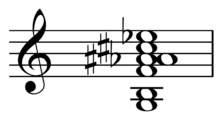
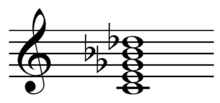
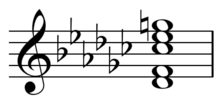
In jazz and jazz harmony, chromatic alteration is either the addition of notes not in the scale, or expansion of a [chord] progression by adding extra non-diatonic chords.[21] For example, "A C major scale with an added D♯ note, for instance, is a chromatically altered scale" while, "one bar of Cmaj7 moving to Fmaj7 in the next bar can be chromatically altered by adding the ii and V of Fmaj7 on the second two beats of bar" one. Techniques include the ii-V-I turnaround, as well as movement by half-step or minor third.[22]
In jazz, the term altered chord, notated as an alt chord (e.g. G7alt ![]()
- root (typically omitted by comping chord-playing instrumentalists)
- 3rd
- ♭5th and/or ♯5th (the ♭5th is often expressed as ♯11)
- ♭7th
- ♭9th and/or ♯9th
- ♭13th
Altered chords may include both a flattened and sharpened form of the altered fifth or ninth, e.g. G7(♭5♯5♭9); however, it is more common to use only one such alteration per tone, e.g. G7(♭5♭9), G7(♭5♯9), G7(♯5♭9), or G7(♯5♯9). in practice, many fake books do not specify all the alterations; the chord is typically just labelled as G7alt, and the alteration of 9ths, 11ths and 13ths is left to the artistic discretion of the comping musician. The use of chords labeled "G7alt" can create challenges in jazz ensembles where more than one chordal instrument are playing chords (e.g., a large band with an electric guitar player and a Hammond organ player), because the guitarist might interpret a G7alt chord as containing a ♭9 and ♭13, whereas the organ player may interpret the same chord as containing a ♯9 and a ♮13; this can lead to clashing harmonies. To deal with this issue, bands with more than one chordal instrument may work out the alt chord voicings beforehand or alternate playing of choruses.
The choice of inversion, or the omission of certain tones within the chord (e.g. omitting the root, common in jazz harmony and chord voicings), can lead to many different possible colorings, substitutions, and enharmonic equivalents. Altered chords are ambiguous harmonically, and may play a variety of roles, depending on such factors as voicing, modulation, and voice leading.
The altered chord's harmony is built on the altered scale (C, Db, Eb, Fb, Gb, Ab, Bb, C), which includes all the alterations shown in the chord elements above:[24]
- root
- ♭9 (=♭2)
- ♯9 (=♯2 or ♭3)
- 3
- ♯11 (=♯4 or ♭5)
- ♭13 (=♯5)
- ♭7
Because they do not have natural fifths, altered dominant (7alt) chords support tritone substitution (♭5 substitution). Thus the 7alt chord on a given root can be substituted with the 13♯11 chord on the root a tritone away (e.g., G7alt is the same as D♭13♯11 ![]()
Altered chords are commonly substituted for regular dominant V chords on the same root in ii-V-I progressions, most commonly in minor harmony leading to a i7 (tonic minor 7th) chord but also in ii/V/I progressions in a major key.
More generally in jazz, the terms altered chord and altered tone also refer to the family of chords that involve ♭9 and ♭5 voicing, as well as to certain other chords with related ambiguous harmony. Thus the "7♭9 chord" (e.g. G7♭9) is used in the context of a dominant resolution to a major tonic, which is typically voiced with a ♮13 rather than the ♭13 of the alt chord. When voiced with a ♮13, jazz musicians typically play the half-step/whole-step diminished scale over the ♭9 chord (e.g. G, A♭, B♭, B, C♯, D, E, F over G7♭9).
Note that in chord substitution and comping (accompaniment by a chordal instrumentalist, such as an electric guitarist or piano player), a 7♭9 is often used to replace a diminished chord, for which it may be the more "correct" substitution due to its incorporation of an appropriate root tone. Thus, in a progression where a diminished chord (denoted °) is written in place of a G7 chord, i.e. where the dominant chord is replaced by an A♭° (A♭–C♭–E![]()
See also
| Look up alteration in Wiktionary, the free dictionary. |
Sources
- 1 2 3 Erickson, Robert (1957). The Structure of Music: A Listener's Guide, p.86. New York: Noonday Press. ISBN 0-8371-8519-X (1977 edition).
- ↑ Blatter, Alfred (2007). Revisiting Music Theory: A Guide to the Practice, p.186. ISBN 0-415-97440-2.
- ↑ Baerman, Noah (1998). Complete Jazz Keyboard Method: Intermediate Jazz Keyboard, p.70. ISBN 0-88284-911-5.
- ↑ Benward and Saker (2009), p.193.
- 1 2 Goetschius, Percy (1889). The Material Used in Musical Composition, p.123-4. G. Schirmer. [ISBN unspecified]
- ↑ Bradley, Kenneth McPherson (1908). Harmony and Analysis, p.119. C. F. Summy. [ISBN unspecified]
- ↑ Norris, Homer Albert (1895). Practical Harmony on a French Basis, Volume 2, p.48. H.B. Stevens. [ISBN unspecified]
- ↑ Goldman, Richard Franko (1965). Harmony in Western Music, p.83-4. Barrie & Jenkins. ISBN 0-214-66680-8
- ↑ Goldman (1965), p.47.
- 1 2 Alfred Music (2013). Mini Music Guides: Piano Chord Dictionary, p.22-3. Alfred Music. ISBN 9781470622244
- 1 2 Haerle, Dan (1983). Jazz Improvisation for Keyboard Players, Book two, p.2.19. Alfred Music. ISBN 9780757930140
- ↑ Baerman (1998), p.71.
- 1 2 3 Aldwell, Edward; Schachter, Carl; and Cadwallader, Allen (2010). Harmony & Voice Leading, p.601. ISBN 9780495189756.
- 1 2 Davis, Kenneth (2006). The Piano Professor Easy Piano Study, p.78. ISBN 9781430303343.
- ↑ Christiansen, Mike (2004). Mel Bay's Complete Jazz Guitar Method, Volume 1, p.45. ISBN 9780786632633.
- ↑ Benward, Bruce; Saker, Marilyn (May 2008). "Glossary", Music in Theory and Practice, Vol. II, p. 355. ISBN 978-0-07-310188-0
- 1 2 Willmott, Bret (2011). Complete Book of Harmony, Theory and Voicing, p.161. Mel Bay. ISBN 9781610650397
- 1 2 Coker, Jerry (1997). Elements of the Jazz Language for the Developing Improvisor, p.81. ISBN 1-57623-875-X.
- 1 2 Baerman, Noah (2000). Jazz Keyboard Harmony, p.40. Alfred Music. ISBN 9780739011072
- 1 2 Baerman (1998), p.74.
- ↑ Arkin, Eddie (2004). Creative Chord Substitution for Jazz Guitar, p.42. ISBN 0-7579-2301-1.
- ↑ Arkin (2004), p.43.
- ↑ Sher (ed.). The New Real Book Volume Two, . Sher Music Co., 1991, ISBN 0-9614701-7-8
- ↑ Brown, Buck; and Dziuba, Mark (2012). The Ultimate Guitar Chord & Scale Bible, p.197. Alfred Music. ISBN 9781470622626 "In a dominant 7 context, this scale contains the root, 3rd, and ♭7 of the dominant chord and includes all of the available tensions: ♭9, ♯9, ♯11, and ♭13.
Further reading
- R., Ken (2012). DOG EAR Tritone Substitution for Jazz Guitar, Amazon Digital Services, Inc., ASIN: B008FRWNIW
